| ?Coffea | ||||||||||||
|---|---|---|---|---|---|---|---|---|---|---|---|---|
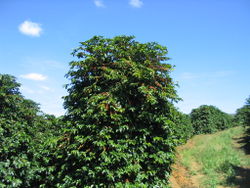
Coffea arabica trees in
Brazil
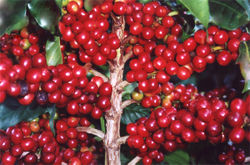
Mature fruit of a Coffea species
|
||||||||||||
| Scientific classification | ||||||||||||
|
||||||||||||
|
Coffea arabica - Arabica Coffee Coffea benghalensis - Bengal coffee Coffea canephora - Robusta coffee Coffea congensis - Congo coffee Coffea excelsa - Liberian coffee Coffea gallienii Coffea bonnieri Coffea mogeneti Coffea liberica - Liberian coffee Coffea stenophylla - Sierra Leonian coffee |
Coffea (coffee) is a genus of ten species of flowering plants in the family Rubiaceae. They are shrubs or small trees, native to subtropical Africa and southern Asia. Seeds of this plant are the source of a stimulating beverage called coffee. The seeds are called "beans" in the trade. Coffee beans are widely cultivated in tropical countries in plantations for both local consumption and export to temperate countries. Coffee ranks as one of the world's major commodity crops and is the major export product of some countries. In fact, coffee ranks second only to petroleum in terms of legally-traded products worldwide.
Contents |
Botany
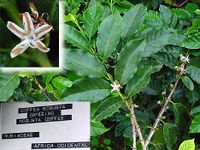
When grown in the tropics coffee is a vigorous bush or small tree easily grown to a height of 33.5 m (1012 feet). It is capable of withstanding severe pruning. It cannot be grown where there is a winter frost. Bushes grow best at high elevations. To produce a maximum yield of coffee berries (800-1400 kg per hectare), the plants need substantial amounts of water and fertilizer. Calcium carbonate and other lime minerals is sometimes used to reduce acidity in the soil, which can occur due to run off of minerals from the soil in mountainous areas.[1]
There are several species of Coffea that may be grown for the beans, but Coffea arabica is considered to have the best quality. The other species (especially Coffea canephora (robusta)) are grown on land unsuitable for Coffea arabica. The tree produces red or purple fruits (drupes, or "coffee berries"), which contain two seeds (the "coffee beans", although not true beans). In about 5-10% of any crop of coffee cherries, the cherry will contain only a single bean, rather than the two usually found. This is called a 'peaberry' and contains a distinctly different flavor profile to the normal crop, with a higher concentration of the flavors, especially acidity, present due to the smaller sized bean. As such, it is usually removed from the yield and either sold separately (such as in New Guinea Peaberry), or discarded.
The coffee tree will grow fruits after 35 years, for about 5060 years (although up to 100 years is possible). The blossom of the coffee tree is similar to jasmine in color and smell. The fruit takes about nine months to ripen. Worldwide, an estimate of 15 billion coffee trees are growing on 100,000 km² of land.
Coffee is used as a food plant by the larvae of some Lepidoptera species including Dalcera abrasa, Turnip Moth and some members of the genus Endoclita including E. damor and E. malabaricus.
Processing
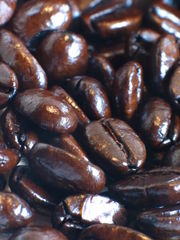
After picking, the coffee beans are pulped (usually using a mechanical pulper) to remove the bulk of the soft flesh, and then the beans are fermented (by one of several means, most often wet fermentation in water for 10 to 36 hours), then washed (to remove the last of the sticky mucilage not removed by fermentation) and dried (usually in the sun). This process is time-consuming, expensive and, for most growers, labour-intensive. Coffee at this stage is known as milled beans.
Once the raw ('green') coffee beans arrive in their destination country, they are roasted; this darkens their color and alters the internal chemistry of the beans and therefore their flavor and aroma. Blending can occur before or after roasting and is often performed to ensure a consistent flavor. Once the beans are roasted, they become much more perishable.
Problems of maintaining quality during bean production
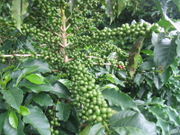
Achieving consistently excellent milled beans is not easy. Problems include:
- Pests on the bushes (e.g., in Hawaii, scale insects and coconut mealy bugs)
- Poor pruning regimes (e.g., too many verticals that allow the bush to attempt too much and so produce inferior cherries)
- Poor fertiliser regimes (e.g., too little iron or insufficient nutriment for what are demanding plants)
- Bad picking (e.g., picking all the berries on a branch rather than those that are bright red, or picking the berries very late)
- Bad fermentation that produces unpleasant taints in the flavor
- Dilution of superior tasting beans with cheaper beans
The coffee bushes fruit aggressively when conditions permit, and the berries will develop at the expense of the rest of the bush. This consumes sugars in the leaves and can produce die-back (death of leaves and branches). Die-back can be severe and can damage not just the current year's production but the next year's production, which is borne on growth during the current year, leading into a two-year cycle of growth and production.
Commercial operators come under a variety of pressures to cut costs and maximise yield. Arguably the best flavours will be produced when the coffee is grown in organic conditions. Some people who grow organically do so primarily to obtain the premium prices organic beans command, an alternative strategy to increase profits.
The economics of growing coffee
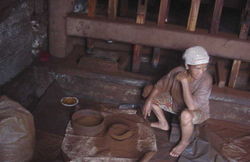
It is very questionable whether small growers can generate a high return on capital growing coffee if they have less than 1.2 ha (3 acres or 12,000 m²) and if they are based in the United States. The retail price of the beans varies between about 1 USD/pound for ripe berries to 9 USD/pound for extra fancy Kona milled beans, and there are many costs including fertiliser, irrigation, labour (e.g. picking and pruning) and land value. Integrated operations that capture much or all of the available revenue (by controlling the whole process from growing to retail) may generate higher returns.
It is estimated that 10 million people are working on plantations in the source lands of coffee. A single worker can harvest 50100 kg of fruits per day, which results in 1020 kg of raw coffee. Crops from Brazil (30%) and Colombia (10%) comprise 40% of the worldwide coffee production. As of 1998, the world's coffee production equals about 100 million sacks of coffee.
Many farmers receive a low price for their coffee because of a global market slump. This has led to coffee being available as a 'fair trade' labelled item in many countries.
Hand picked coffee
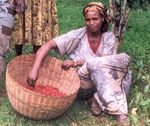
The highest quality coffee is generally hand picked. Normally, coffee growers harvest their coffee with portable vacuum packs, which the pickers wear on their backs and brush over the branches of the coffee bushes. Although it is much more efficient and quick to harvest the coffee with the vacuum packs, coffee beans do not become ripe at the same time, even if they are on the same tree, and thus many unripe beans are sucked away by the vacuum packs. Also, coffee pickers are sure to pick beans only of the highest quality. As a general rule, hand picked coffee is used for drip machines, while vacuum picked coffee is used to make instant coffee and decaffeinated coffee.
History
Coffee probably originated in the Kingdom of Kaffa (now part of the Southern Nations, Nationalities, and Peoples Region of Ethiopia), though there is controversy about its origins, with Yemen also suggested as an area of origin. One apocryphal tale claims that an Ethiopian goat-herder noticed his goats prancing about energetically, and found they were eating coffee berries, and tried some himself.
The crop first became popular in Arabia around the 13th century, and Islam's prohibition against alcoholic beverages probably enhanced its popularity. Before 1600, coffee production was a jealously guarded secret, and fertile beans were not found outside Arabia. Many consider the German botanist Leonhard Rauwolf to have first described coffee in a book published in 1583. Sometime after 1600, coffee trees were grown in India, possibly due to smuggling of fertile beans. Around 1650, coffee importation into England began and coffeehouses opened in Oxford and London. Coffee planting began in the English colonies, but a disease wiped out the plantations, leading the English to re-plant with tea instead.
By the 18th century, the beverage had become popular in Europe, and European colonists had introduced coffee to tropical countries worldwide as a plantation crop to supply domestic demand. At the end of the 19th century, plantations in Brazil alone were producing over 80% of the world's coffee crop. At the same time, European demand for coffee was so strong that when genuine coffee beans were scarce, people developed similar-tasting substitutes from various roasted vegetable substances, such as chicory root, dandelion root, acorns, or figs. For example, the British used acorns as a coffee substitute during World War II when German U-boats blockaded Britain.
The major coffee-producing countries are Brazil, Colombia, Vietnam, Indonesia, Costa Rica, Mexico, India, and Puerto Rico but coffee is grown in over 70 countries (2003 USDA and ICO data). Major importers are United States, Germany, Japan, France, Italy, and Spain (2002 USDA data), and per-capita consumers of coffee are Finland (11 kg), Denmark (9.7 kg), Norway (9.5 kg), Sweden (8.6 kg), and Austria (7.8 kg). The United States, while the largest importing country, only ranks 16th (4.1 kg) in per-capita consumption (2001 USDA data).
External links
- Coffee & Conservation - Many resources on sustainable coffee, including reviews, especially shade coffee and biodiversity
- Just About Coffee General information webpage about the coffee tree subject.
- Coffea arabica by James A. Duke detailed information about this species.
- Excellent article about the nutritional needs of coffee plants (written by an expert in Hawaii).
- University of Hawaii spreadsheets dealing with costs of production including those of coffee growing in Hawaii.
- Farmers Bookshelf guide to coffee growing and processing in Hawaii.
- Coffee Forums (offers open discussion about coffee, the beans, machines and effects).
- How To Brew Coffee (consists of coffee information and tutorials on various types of brewing including Turkish and Vietnamese).
- United States Department of Agriculture Foreign Agriculture Service (a valuable source of coffee (and other commodities) production and consumption data).
- TooMuchCoffee: The European Coffee and Espresso Resource (offers non-commercial articles and discussion about coffee, coffee preparations and homeroasting; interesting documentary (15 MB) about coffee planters in Nicaragua available for free download).
- The etymology of the word coffee




 216.73.216.81
216.73.216.81 User Stats:
User Stats:
 Today: 0
Today: 0 Yesterday: 0
Yesterday: 0 This Month: 0
This Month: 0 This Year: 0
This Year: 0 Total Users: 117
Total Users: 117 New Members:
New Members:
 216.73.xxx.xx
216.73.xxx.xx
 Server Time:
Server Time: